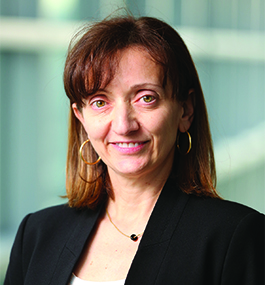Setting the Stage for a New Wave of Exploration

Gabriella Sciolla
by Jarret Bencks
More than 300 feet underground, outside Geneva, Switzerland, trillions and trillions of subatomic particles streak around a massive man-made track at nearly the speed of light. As the particles collide and break apart, sensors record and relay a treasure trove of data to supercomputers. Physicists from around the globe study the data in pursuit of answering — and asking — fundamental questions about the universe.
This powerful particle accelerator, known as the Large Hadron Collider, was built by the European Organization for Nuclear Research, or CERN. It’s where some of modern physics’ most significant discoveries have been made, including the 2012 identification of the Higgs boson, the culmination of a 50-year search. The Higgs particle gives mass to all other particles. Until a decade ago, it was the missing piece of the Standard Model of particle physics, currently the best theory explaining the forces locked inside infinitesimal specks of matter and the laws governing that matter, the building block of everything from humans to galaxies.
Brandeis’ high-energy physics group played a leading role in developing the technology used to discover and research the Higgs over the past decade, in the global collaborations known as the ATLAS and CMS experiments. Now the collider is set to be upgraded to make still more revolutionary discoveries, and Brandeis physicists are poised to lead in the exploration of the universe.
While the Higgs discovery solved a long mystery, it also opened the door to numerous new, fundamental questions to explore.
“Understanding what the Higgs is and testing it for the first time against the predictions of the [Standard Model] theory is just as important as discovering the particle,” says Gabriella Sciolla, who joined the Brandeis physics group in 2011.
Exploring the behavior of the Higgs may even hold the answer to one of the universe’s greatest mysteries: dark matter. While the Standard Model offers an explanation for particles that can be detected by light, these particles account for only about 15% of the universe’s mass. The rest is dark matter, mysterious and difficult to detect — the frontier of physics.
CERN is preparing to upgrade the LHC to increase its luminosity by a factor of 10, enabling more frequent — and powerful — collisions to occur. The upgrade also requires new, more durable, and more sensitive detectors.
At Brookhaven National Laboratory, a U.S. Department of Energy facility on Long Island, New York, Sciolla is the U.S. coordinator for the creation of an all-silicon inner tracking detector for the ATLAS experiment.
“Every single chip we use has to be custom-designed, and they all have to be extremely fast, because they are going to take huge amounts of data per second,” Sciolla says.
The collider upgrades, which should be finished by 2029, could make possible the observation of never-before-captured self-interactions of the Higgs.
